- Home
- About Journals
-
Information for Authors/ReviewersEditorial Policies
Publication Fee
Publication Cycle - Process Flowchart
Online Manuscript Submission and Tracking System
Publishing Ethics and Rectitude
Authorship
Author Benefits
Reviewer Guidelines
Guest Editor Guidelines
Peer Review Workflow
Quick Track Option
Copyediting Services
Bentham Open Membership
Bentham Open Advisory Board
Archiving Policies
Fabricating and Stating False Information
Post Publication Discussions and Corrections
Editorial Management
Advertise With Us
Funding Agencies
Rate List
Kudos
General FAQs
Special Fee Waivers and Discounts
- Contact
- Help
- About Us
- Search

The Open Materials Science Journal
(Discontinued)
ISSN: 1874-088X ― Volume 13, 2019
Characteristic Analysis and Applications of Electromagnetic Shielding Materials for Wireless Communications Device
Han-Nien Lin1, *, Ya-Ying Chen1, Hung-Yun Tsai1, Min-Shan Lin2
Abstract
As the trend of consumer electronics and mobile communications devices is obviously developing toward to miniature and high-speed processing, the problem involving with electromagnetic compatibility (EMC) or radio frequency interference (RFI) is becoming more critical for the system integration of high-speed digital and RF mixed signal platforms. This paper is mainly focusing on the characteristics analysis of various electromagnetic shielding materials by utilizing the various shielding effectiveness (SE) measuring methods developed by TDK and ASTM (ASTM D4935). We also adopt the electromagnetic interference (EMI) testing methods developed by IEC for chip level (IEC 61967-3 and IEC 61967-6) to investigate the characteristics and distribution of EMI noise sources. To effectively shield the electric, magnetic, or electromagnetic field originated from noise source, we thus analyze the shielding capability for various materials with different measuring methods. Finally, we will show the EMI reduction and RF performance improvement with implementation of shielding material on module under investigated. With the systematic measurement and analysis described in this paper, we can further identify the related EMI problem and resolve the severe chip or module level EMC problem more effectively.
Article Information
Identifiers and Pagination:
Year: 2016Volume: 10
Issue: Suppl-1, M5
First Page: 44
Last Page: 53
Publisher Id: TOMSJ-10-44
DOI: 10.2174/1874088X01610010044
Article History:
Received Date: 9/4/2015Revision Received Date: 15/5/2015
Acceptance Date: 8/7/2015
Electronic publication date: 15/07/2016
Collection year: 2016
open-access license: This is an open access article licensed under the terms of the Creative Commons Attribution-Non-Commercial 4.0 International Public License (CC BY-NC 4.0) (https://creativecommons.org/licenses/by-nc/4.0/legalcode), which permits unrestricted, non-commercial use, distribution and reproduction in any medium, provided the work is properly cited.
* Address correspondence to this author at Department of Communications Engineering, Feng Chia University, Taichung City 40724, Taiwan; E-mail: hnlin@fcu.edu.tw
| Open Peer Review Details | |||
|---|---|---|---|
| Manuscript submitted on 9-4-2015 |
Original Manuscript | Characteristic Analysis and Applications of Electromagnetic Shielding Materials for Wireless Communications Device | |
INTRODUCTION
Wireless applications of Cloud and Internet connection attract the most industrial attention for the past few years. Meanwhile, with the development of IC technologies advancing toward higher circuit density and operating frequency with the trend of miniaturization on wireless communication products, the circuits and components are placed much closer inside the mobile devices than ever before. The system with highly integrated high-speed digital circuits and multi-radio modules are now facing the severe challenge from performance degradation by even more complicated platform EMI noisy environment [1Han-Nien Lin. Analysis of platform noise effect on performance of wireless communication
devices. In: Wireless Communications. Rijeka, Croatia: InTech-Open Access Publisher 2012; pp. 177-226.-4Lin H-N, Chang J-L, Kuo C-W. Radiated EMI coupling analysis between high-speed modules and receiving antennas of mobile devices. In: 2012-Asia-Pacific Symposium Electromagnetic Compatibility; 2012 May 21-24; Singapore: IEEE 2012.
[http://dx.doi.org/10.1109/APEMC.2012.6237825] ]. The unintentionally radiated EMI noises emitted from digital IC/module may couple to nearby sensitive analogue circuit/sensor or antenna and thus severely impact the receiving performance (sensitivity) of system [5Lin H-N, Hunag W-H, Lai W-J. The impact and root cause analysis of USB 3.0 module on wireless communications with improved solution
for EMI problem of high speed connectors. In: PIERS Proceeding. Taipei: Taiwan 2013; pp. 910-4.-8Lin Han-Nien, Chiang Po-Yu, Tsai Wang-Chwen, Chen Cheng-Chang. The analysis of receiving sensitivity degradation of WLAN performance due to EMI noise from SSD module. In: PIERS Proceeding. Guangzhou (Canton): China 2014.]. Besides the unintentional coupling between digital noise and sensitive circuit, there is also a serious co-channel and adjacent channel interference problem for co-existing multi-radio systems. The degradation of RF performance due to decrease of S/N usually results in reduction of communications range or data rate, and it will affect the user s quality of experience (QoE).
Since the system in package (SiP) technology is becoming more popular recently owing to the miniaturization of various wearable and wireless communications products, the placement layout and trace routing of circuits and components become much denser and bring the EMC issues for system integration. Therefore, we have investigated the EMI noise coupling characteristics of commonly embedded digital devices (as shown in Fig. 1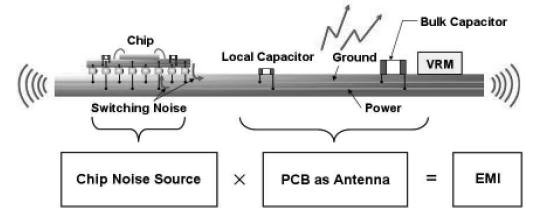 ) and analysed the various shielding effectiveness measuring methods (as shown in Fig. 2
) and analysed the various shielding effectiveness measuring methods (as shown in Fig. 2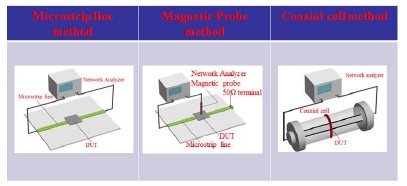 ) on electromagnetic shielding materials for further high performance wearable and wireless communications design.
) on electromagnetic shielding materials for further high performance wearable and wireless communications design.
 |
Fig. (1) Mechanism of EMI noise coupling. |
 |
Fig. (2) Schematics of measuring setup for electromagnetic shielding material. |
 |
Fig. (3) Principle and test setup of microstrip line method. |
ANALYSIS OF EXPERIMENTAL MATERIALS AND MEASUREMENT METHODS
Microstrip Line Method (Test For Filtering)
The microstrip line method shown in Fig. (3 ) is developed by TDK for shielding effectiveness measurement on electromagnetic shielding material [9 TDK Corporation. TDK Flexield-EMI test method, BSF-B05CC, 2012.]. The method is to place the material under test (MUT) on top of 50Ω microstrip line. Since the shielding material on top of microstrip line will affect line s impedance, it will thus provide high impedance and suppress the high frequency components of signals and further achieve the filtering function. In this paper, we will illustrate the measurement of two different shielding materials (Graphene and magnetic material FAM 5(0.2 mm)), and also show the effect of different stack-up arrangement on shielding or filtering effectiveness. The comparison of the various measurement results is shown in Fig. (4
) is developed by TDK for shielding effectiveness measurement on electromagnetic shielding material [9 TDK Corporation. TDK Flexield-EMI test method, BSF-B05CC, 2012.]. The method is to place the material under test (MUT) on top of 50Ω microstrip line. Since the shielding material on top of microstrip line will affect line s impedance, it will thus provide high impedance and suppress the high frequency components of signals and further achieve the filtering function. In this paper, we will illustrate the measurement of two different shielding materials (Graphene and magnetic material FAM 5(0.2 mm)), and also show the effect of different stack-up arrangement on shielding or filtering effectiveness. The comparison of the various measurement results is shown in Fig. (4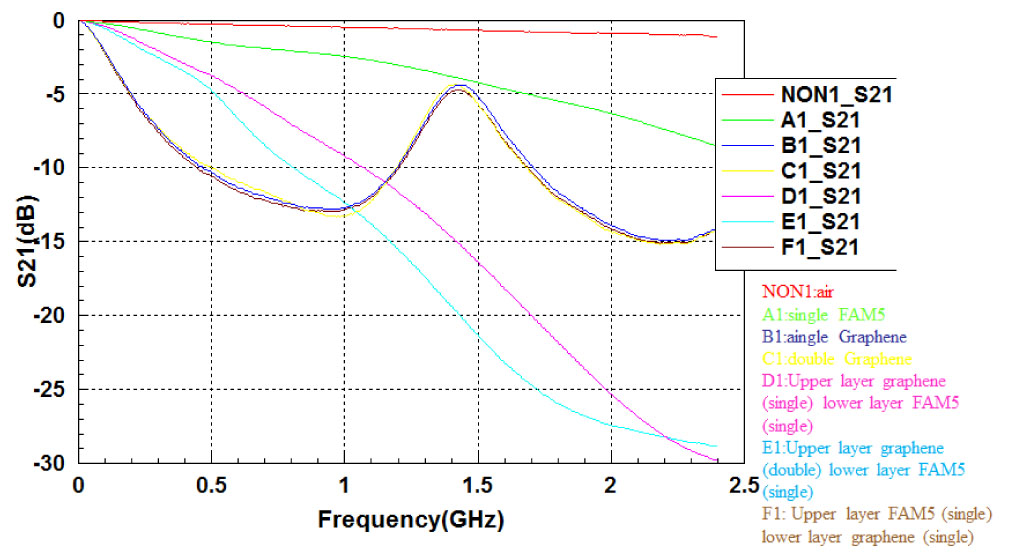 ).
).
 |
Fig. (4) Measurement results with microstrip line method. |
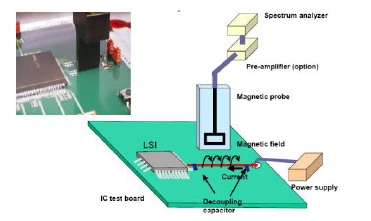 |
Fig. (5) Schematic of IEC 61967-6 magnetic probe method. |
 |
Fig. (6) Simulation configuration and results of material coupling effect on trace with magnetic probe method. |
Magnetic Probe Method (Test For Magnetic Shielding)
The magnetic probe method [10 Integrated Circuits-Measurement of Electromagnetic Emissions, Part 6: Measurement of Radiated Emissions –Magnetic Probe Method, IEC 61967-6, Pre-release of official standard, 2002. Available at: https://webstore.iec.ch/publication/6193] illustrated in this paper is utilizing the magnetic probe described in IEC 61967-6 for chip level EMI measurement from trace as shown in Fig. (5 ) The probe is designed here to measure the magnetic flux generated by 50Ω microstrip line. With the attenuation or detour of magnetic flux by shielding material, the shielding effectiveness can be obtained with received flux or induced voltage via magnetic probe. In this study, we first use copper for electromagnetic simulation and testing experiment to investigate the coupling effect between microstrip line and material under test to identify the real shielding mechanism (impedance mismatching, reflection, or absorption). The simulation configuration and results are illustrated as shown in Fig. (6
) The probe is designed here to measure the magnetic flux generated by 50Ω microstrip line. With the attenuation or detour of magnetic flux by shielding material, the shielding effectiveness can be obtained with received flux or induced voltage via magnetic probe. In this study, we first use copper for electromagnetic simulation and testing experiment to investigate the coupling effect between microstrip line and material under test to identify the real shielding mechanism (impedance mismatching, reflection, or absorption). The simulation configuration and results are illustrated as shown in Fig. (6 ). It shows that the impedance of signal trace is severely affected by the proximity of shielding material, and thus impairs the signal integrity. To avoid the measurement problem and error invoked by this proximity effect, we further increase the separation between the microstrip line and material under test to assure the resultant shielding effectiveness obtained indeed the desired energy attenuation mainly by reflection or absorption against filtering mentioned in previous test configuration.
). It shows that the impedance of signal trace is severely affected by the proximity of shielding material, and thus impairs the signal integrity. To avoid the measurement problem and error invoked by this proximity effect, we further increase the separation between the microstrip line and material under test to assure the resultant shielding effectiveness obtained indeed the desired energy attenuation mainly by reflection or absorption against filtering mentioned in previous test configuration.
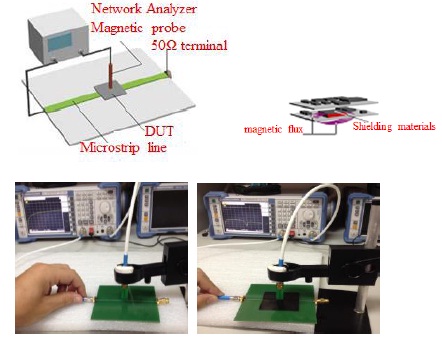 |
Fig. (7) Test setup of magnetic probe method for shielding effectiveness. |
 |
Fig. (8) Measured results with 1mm spacing as specified by IEC 61967-6 (with proximity effect). |
The test setup of magnetic probe method is shown in Fig (7 ) and the measured results with 1mm spacing as required by IEC 61967-6 are shown in Fig. (8
) and the measured results with 1mm spacing as required by IEC 61967-6 are shown in Fig. (8 ). As to avoid proximity coupling effect influcing the measuring accuracy, we increase the separate between the microstrip line and material under test and not fix at 1mm height as specified in IEC 61967-6. The measured results with larger separation to avoid proximity effect are shown in Fig. (9
). As to avoid proximity coupling effect influcing the measuring accuracy, we increase the separate between the microstrip line and material under test and not fix at 1mm height as specified in IEC 61967-6. The measured results with larger separation to avoid proximity effect are shown in Fig. (9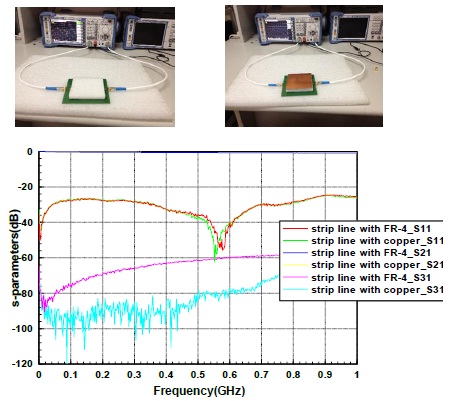 ).
).
 |
Fig. (9) The test illustration and measured results with larger separation to avoid proximity effect. |
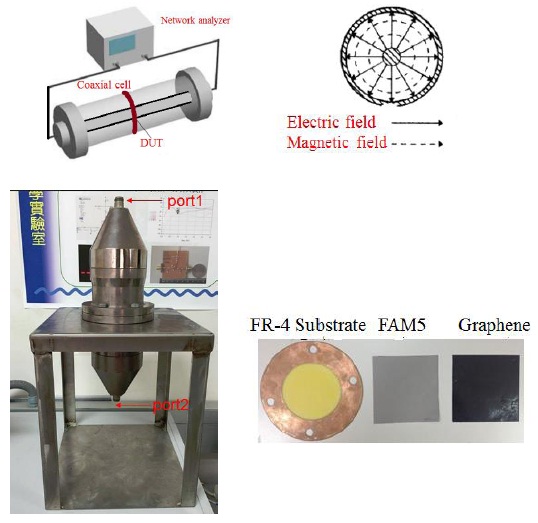 |
Fig. (10) Measurement principle and setup of coaxial cell method. |
Coaxial Cell Method (Test For Electromagnetic Shielding)
The coaxial cell method utilizes the coaxial transmission line configuration described in ASTM D 4935 [11ASTM International. Standard Test Method for Measuring the Electromagnetic Shielding Effectiveness of Planar Materials. ASTM D 4935-10, West Conshohocken: PA 2010.
] and is illustrated in Fig. (10 ). The coaxial transmission line (CTL) is the most widely used measurement system in transmission-reflection (TR) methods. CTL systems have been used to measure EM shielding effectiveness (SE) of planar shields [12Nicolson AM, Ross GF. Measurement of the intrinsic properties of materials by time-domain techniques. IEEE Trans Instrum Meas Nov. 1970; 19(4): 377-82.
). The coaxial transmission line (CTL) is the most widely used measurement system in transmission-reflection (TR) methods. CTL systems have been used to measure EM shielding effectiveness (SE) of planar shields [12Nicolson AM, Ross GF. Measurement of the intrinsic properties of materials by time-domain techniques. IEEE Trans Instrum Meas Nov. 1970; 19(4): 377-82.
[http://dx.doi.org/10.1109/TIM.1970.4313932] -14Vasquez H, Espinoza L, Lozano K, Foltz H, Yang S. Simple Device for Electromagnetic Interference Shielding Effectiveness Measurement, IEEE EMC Society Newsletter 2009; (220): 62-8.] the experiment setup for measuring the scattering parameters of the single-layered RF absorber, which includes a vector network analyzer and a 50-Ohm coaxial sample holder. The coaxial sample holder, being an enlarged coaxial line to hold an MUT, is designed to have an inner radius (b) of 38 mm for the outer conductor and a radius (a) of 16 mm for the inner conductor. The characteristic impedance (ZC) and the upper frequency limit for pure transverse EM (TEM) mode operation can be computed as  , respectively [6Lin H-N, Hsieh D, Huang W-H, Chou Y-C. Effect on RF receiving sensitivity and near field EMC analysis of solid state drive (SSD), In: 2013 Asia-Pacific Radio Science Conference, EDBK-4. Taipei: Taiwan 2013: p. 9.], where εr is the dielectric constant of the material between the inner and outer conductors, which for air (without filling material) is equal to 1, and v is the speed of light equal to 3 x 108m/s . We investigate two different shielding materials (Graphene and magnetic material FAM5 (0.2 mm)), and also analyze the effect of different stack-up arrangement on shielding effectiveness. The measured results for different material stack-up combinations with coaxial cell method are shown in Fig. (11
, respectively [6Lin H-N, Hsieh D, Huang W-H, Chou Y-C. Effect on RF receiving sensitivity and near field EMC analysis of solid state drive (SSD), In: 2013 Asia-Pacific Radio Science Conference, EDBK-4. Taipei: Taiwan 2013: p. 9.], where εr is the dielectric constant of the material between the inner and outer conductors, which for air (without filling material) is equal to 1, and v is the speed of light equal to 3 x 108m/s . We investigate two different shielding materials (Graphene and magnetic material FAM5 (0.2 mm)), and also analyze the effect of different stack-up arrangement on shielding effectiveness. The measured results for different material stack-up combinations with coaxial cell method are shown in Fig. (11 ).
).
 |
Fig. (11) Measured results with coaxial cell method. |
APPLICATION OF SHIELDING MATERIALS FOR WIRELESS COMMUNICATIONS
Surface Scan Method (For Electromagnetic Field Distribution Measurement)
Surface scan method referred to IEC 61967-3 is originally developed to identify the EMI noise sources and measure electromagnetic field distribution across the chip level [15Integrated Circuits-Measurement of Electromagnetic Emissions, Part 3: Measurement of Radiated Emissions – Surface Scan Method, IEC 61967-3 2005. Available at: https://webstore.iec.ch/publication/6186]. The test mode is to activate the integrated circuit (IC) under test and empower auxiliary circuits on the PCB test board for normal operation, and then measure the near-field emitted electromagnetic energy for all dominant EMI frequencies. The test method utilizes the miniaturized E-probe, H-probe, or electromagnetic probe to scan the whole surface of IC die or package in the near-field region for each dominant EMI frequencies. With the multi-layer scanning of near-field emission, we can also reconstruct the EMI radiation of the noise source inside the chip under test. The positioning system of field probe and controlling software provides the accurate spatial step and orientation of measurement probe, and thus assures the repeatable and reproducible measured results. The test setup for near-field surface scan method is shown in Fig. (12 ).
).
 |
Fig. (12) Illustration of near-field scan method. |
To illustrate the application of shielding material for wireless device, we use an Android wireless (WiFi and Bluetooth) micro-projector as a demonstration as shown in Fig. (13 ). We analyze the data rate reduction of WiFi connection by measuring the antenna port noise level to quantify the signal-to-noise ratio (SNR) first, and then utilize the near-field scan method to electromagnetically scan the complete area of projector to identify and characterize the EMI noise source. The measured result is illustrated with hot-spot graph as shown in Fig. (14
). We analyze the data rate reduction of WiFi connection by measuring the antenna port noise level to quantify the signal-to-noise ratio (SNR) first, and then utilize the near-field scan method to electromagnetically scan the complete area of projector to identify and characterize the EMI noise source. The measured result is illustrated with hot-spot graph as shown in Fig. (14 ), and the red area indicates the most serious and noisy EMI region. We then further locate the specific scanning area on dominant noisy IC for analysis, and finally apply the shielding material on top of the noisy IC to improve the wireless communications performance. The measured EMI results of dominantly noisy IC without and with shielding material are shown in Figs. (15
), and the red area indicates the most serious and noisy EMI region. We then further locate the specific scanning area on dominant noisy IC for analysis, and finally apply the shielding material on top of the noisy IC to improve the wireless communications performance. The measured EMI results of dominantly noisy IC without and with shielding material are shown in Figs. (15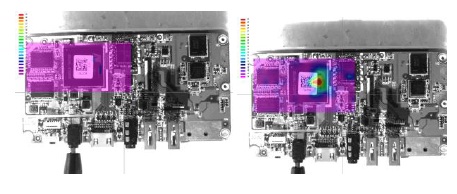 -17
-17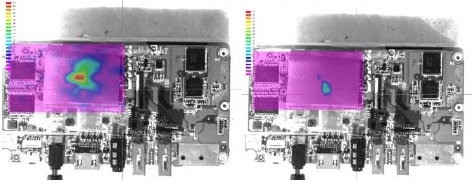 ) respectively, and also show the EMI level reduction with the shielding materials.
) respectively, and also show the EMI level reduction with the shielding materials.
 |
Fig. (13) Wireless micro-projector with wifi and bluetooth RF modules. |
 |
Fig. (14) Near-field surface scanned result of wireless micro-projector (before applying shielding material). |
 |
Fig. (15) Near-field surface scanned result of dominant EMI IC with parallel (left) and perpendicular (right) probe orientation (before applying shielding material). |
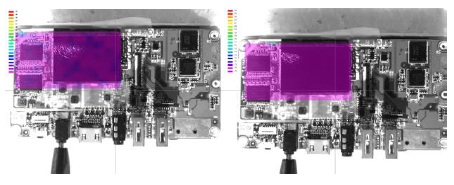 |
Fig. (16) Near-field surface scanned result of dominant EMI IC with parallel (left) and perpendicular (right) probe orientation (applying graphene). |
 |
Fig. (17) Near-field surface scanned result of dominant EMI IC with parallel (left) and perpendicular (right) probe orientation (applying FAM 5). |
Platform Noise Test Method (Antenna Port Noise Level Measurement)
To quantify the improvement of shielding material on wireless communications performance, we measure the antenna port noise level to show the increase of signal-to-noise ratio (SNR) by reducing the EMI level with shielding material. The platform noise under investigation is analyzed by noise floor measurement system. The complete PNS (platform noise measuring system) is composed of shielded box, pre-amplifier, spectrum analyzer, and EUT (Micro-projector). The noise level measuring system and setup for EUT in frequency domain is shown in Fig. (18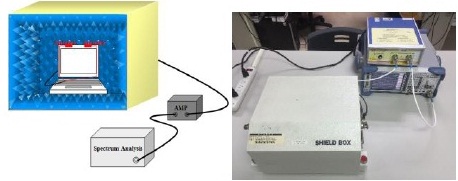 ).
).
The test configuration of EUT and results for platform noise measurement to verify SNR improvement without/with shielding material is shown in Fig. (19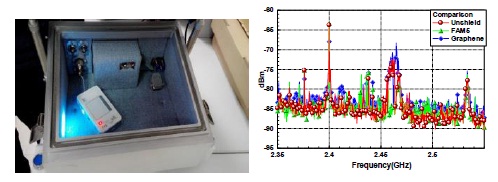 ). The measured results clearly finds the increasing SNR by reducing the EMI level of noisy IC around 2.4 GHz WiFi frequency band with shielding material, and thus improve the performance of wireless communications.
). The measured results clearly finds the increasing SNR by reducing the EMI level of noisy IC around 2.4 GHz WiFi frequency band with shielding material, and thus improve the performance of wireless communications.
 |
Fig. (18) Setup for antenna port noise level measurement. |
 |
Fig. (19) Test configuration and noise level for antenna port noise measurement. |
CONCLUSION
This work first analyzes the different shielding mechanism by the utilization of various shielding effectiveness (SE) measurement method , such as microstrip line method developed by TDK, ASTM 4935 coaxial cell method, and chip level EMI measurement methods IEC 61967-3 and -6. Those test methods are applicable to characterize filtering, magnetic shielding, and electromagnetic shielding measurement respectively. We finally demonstrate the improvement on WiFi performance of the wireless micro-projector by the use of shielding material. By near-field surface scanning on electromagnetic field distribution of noisy PCB/module, we can further analyze and investigate the application of shielding material to improve the system EMC performance. With the trend of highly integrated system and system in package (SiP), the shielding material will be widely applied and should be used adequately to effective shield the EMI source. We will continually investigate the shielding performance of various materials with different combination of layer stack-up arrangement, material grounding schemes and applications on chip and SiP level to further improve the system/module/chip performance.
CONFLICT OF INTEREST
The authors confirm that this article content has no conflicts of interest.
ACKNOWLEDGEMENTS
In this work, authors would like to thank the BSMI (Bureau of Standards, Metrology and Inspection) and Ministry of Science & Technology of Taiwan, for their financial grants support to this study.
REFERENCES
| [1] | Han-Nien Lin. Analysis of platform noise effect on performance of wireless communication devices. In: Wireless Communications. Rijeka, Croatia: InTech-Open Access Publisher 2012; pp. 177-226. |
| [2] | Lin H-N, Laio A, Tseng Y-L, Lin M-S. Verification analysis of electromagnetic coupling between display module and antenna of mobile devices for wireless communications. In: PIERS Proceeding. Taipei: Taiwan, 2013; pp. 915-8. |
| [3] | Lin Han-Nien, Kuo Chung-Wei, Chang Jia-Li, Chen Chiu-Kuo. Statistical analysis of EMI noise measurement for flash memory EMC compo. In: 8th Workshop on Electromagnetic Compatibility of Integrated Circuits. Croatia: IEEE 2011; pp. 45-250. |
| [4] | Lin H-N, Chang J-L, Kuo C-W. Radiated EMI coupling analysis between high-speed modules and receiving antennas of mobile devices. In: 2012-Asia-Pacific Symposium Electromagnetic Compatibility; 2012 May 21-24; Singapore: IEEE 2012. [http://dx.doi.org/10.1109/APEMC.2012.6237825] |
| [5] | Lin H-N, Hunag W-H, Lai W-J. The impact and root cause analysis of USB 3.0 module on wireless communications with improved solution for EMI problem of high speed connectors. In: PIERS Proceeding. Taipei: Taiwan 2013; pp. 910-4. |
| [6] | Lin H-N, Hsieh D, Huang W-H, Chou Y-C. Effect on RF receiving sensitivity and near field EMC analysis of solid state drive (SSD), In: 2013 Asia-Pacific Radio Science Conference, EDBK-4. Taipei: Taiwan 2013: p. 9. |
| [7] | Lin H-N, Lu C-C, Chiang P-Y, Kung T-W. The analysis of EMI noise coupling mechanism for GPS reception performance degradation from SSD/USB module, In: 2014 International Symposium on Electromagnetic Compatibility. Tokyo: IEEE 2014; pp. 350-3. 2014/05/12-2014/05/16 |
| [8] | Lin Han-Nien, Chiang Po-Yu, Tsai Wang-Chwen, Chen Cheng-Chang. The analysis of receiving sensitivity degradation of WLAN performance due to EMI noise from SSD module. In: PIERS Proceeding. Guangzhou (Canton): China 2014. |
| [9] | TDK Corporation. TDK Flexield-EMI test method, BSF-B05CC, 2012. |
| [10] | Integrated Circuits-Measurement of Electromagnetic Emissions, Part 6: Measurement of Radiated Emissions –Magnetic Probe Method, IEC 61967-6, Pre-release of official standard, 2002. Available at: https://webstore.iec.ch/publication/6193 |
| [11] | ASTM International. Standard Test Method for Measuring the Electromagnetic Shielding Effectiveness of Planar Materials. ASTM D 4935-10, West Conshohocken: PA 2010. |
| [12] | Nicolson AM, Ross GF. Measurement of the intrinsic properties of materials by time-domain techniques. IEEE Trans Instrum Meas Nov. 1970; 19(4): 377-82. [http://dx.doi.org/10.1109/TIM.1970.4313932] |
| [13] | ASTM International. Standard Test Method for Measuring the Electromagnetic Shielding Effectiveness of Planar Materials, ASTM D 4935-99, West Conshohocken: PA 1999. |
| [14] | Vasquez H, Espinoza L, Lozano K, Foltz H, Yang S. Simple Device for Electromagnetic Interference Shielding Effectiveness Measurement, IEEE EMC Society Newsletter 2009; (220): 62-8. |
| [15] | Integrated Circuits-Measurement of Electromagnetic Emissions, Part 3: Measurement of Radiated Emissions – Surface Scan Method, IEC 61967-3 2005. Available at: https://webstore.iec.ch/publication/6186 |



